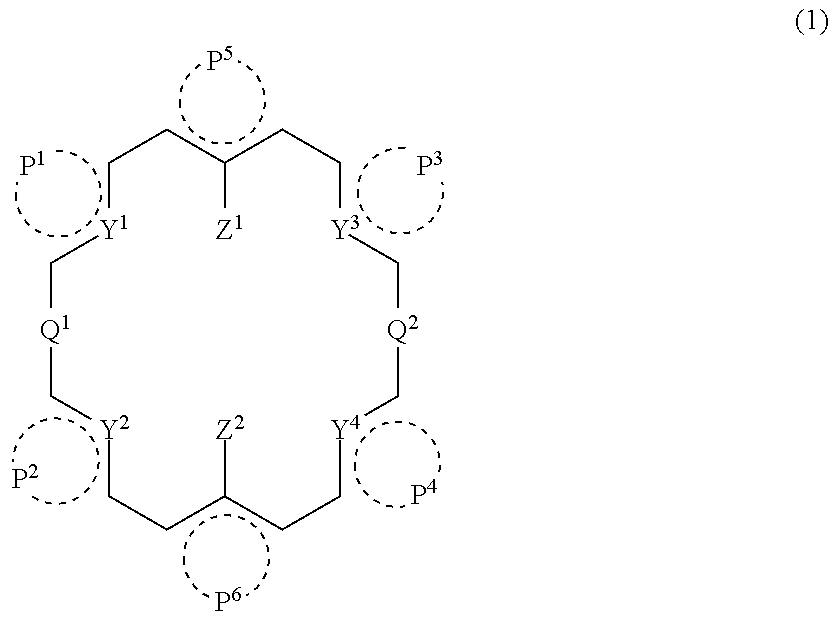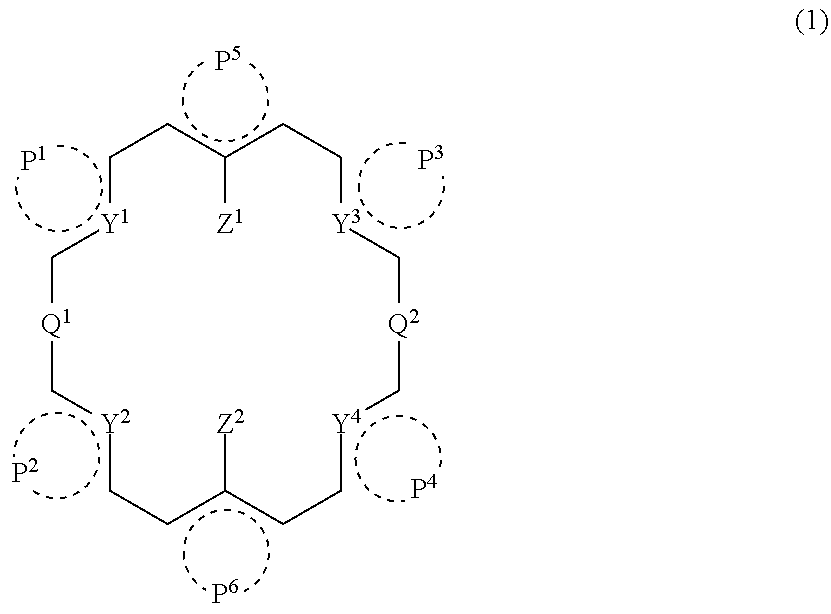Cyclic compound, its metal complex and modified metal complex
- Summary
- Abstract
- Description
- Claims
- Application Information
AI Technical Summary
Benefits of technology
Problems solved by technology
Method used
Image
Examples
example 1
Under an argon atmosphere, 3.945 g of 2,9-(3′-bromo-5′-tert-butyl-2′-methoxyphenyl)-1,10-phenanthroline (synthesized by the method described in Tetrahedron., 1999, 55, 8377), 3.165 g of 1-N-Boc-pyrrole-2-boronic acid (manufactured by Frontier Scientific), 0.138 g of tris(benzylideneacetone)dipalladium, 0.247 g of 2-dicyclohexylphosphino-2′,6′-dimethoxybiphenyl, and 5.527 g of potassium phosphate were dissolved in mixed solvent of 200 mL of dioxane and 20 mL of water, and the solution was stirred at 60° C. for 6 hours. After the completion of the reaction, the solution was left standing to cool, distilled water and chloroform were added to the solution, and an organic layer was extracted. The resultant organic layer was concentrated, whereby a black residue was obtained. The residue was purified with a silica gel column, whereby Compound (A) was obtained.
1H-NMR (300 MHz, CDCl3) δ1.34 (s, 18H), 1.37 (s, 18H), 3.30 (s, 6H), 6.21 (m, 2H), 6.27 (m, 2H), 7.37 (m, 2H), 7.41 (s, 2H), 7.82 (...
example 2
Under a nitrogen atmosphere, 0.904 g of Compound (A) was dissolved in 10 mL of anhydrous dichloromethane. While the dichloromethane solution was cooled to −78° C., 8.8 mL of boron tribromide (1.0-M dichloromethane solution) was slowly dropped to the dichloromethane solution. After the dropping, the mixture was stirred for 10 minutes, and was then left to stand while being stirred so that its temperature might reach room temperature. Three hours after that, the reaction solution was cooled to 0° C., and a saturated aqueous solution of NaHCO3 was added to the solution. After that, an organic layer was extracted by adding chloroform to the mixture, and was then concentrated. The obtained brown residue was purified with a silica gel column, whereby Compound (B) was obtained.
1H-NMR (300 MHz, CDCl3) δ1.40 (s, 18H), 6.25 (m, 2H), 6.44 (m, 2H), 6.74 (m, 2H), 7.84 (s, 2H), 7.89 (s, 2H), 7.92 (s, 2H), 8.35 (d, J=8.4 Hz, 2H), 8.46 (d, J=8.4 Hz, 2H), 10.61 (s, 2H), 15.88 (s, 2H)
example 3
Into 5 mL of propionic acid were dissolved 0.061 g of Compound (B) and 0.012 g of benzaldehyde, and the solution was heated at 140° C. for 7 hours. Thereafter, propionic acid was distilled off, and the resultant black residue was purified through a silica gel column to yield Macrocyclic Compound (C).
1H-NMR (300 MHz, CDCl3) δ1.49 (s, 18H), 6.69 (d, J=4.8 Hz, 2H), 7.01 (d, J=4.8 Hz, 2H), 7.57 (m, 5H), 7.90 (s, 4H), 8.02 (s, 2H), 8.31 (d, J=8.1 Hz, 2H), 8.47 (d, J=8.1 Hz, 2H)
Macrocyclic Compound (F) was synthesized via Compound (D) and Compound (E) in accordance with the following reaction formula.
PUM
| Property | Measurement | Unit |
|---|---|---|
| Temperature | aaaaa | aaaaa |
| Temperature | aaaaa | aaaaa |
| Temperature | aaaaa | aaaaa |
Abstract
Description
Claims
Application Information
 Login to View More
Login to View More - R&D
- Intellectual Property
- Life Sciences
- Materials
- Tech Scout
- Unparalleled Data Quality
- Higher Quality Content
- 60% Fewer Hallucinations
Browse by: Latest US Patents, China's latest patents, Technical Efficacy Thesaurus, Application Domain, Technology Topic, Popular Technical Reports.
© 2025 PatSnap. All rights reserved.Legal|Privacy policy|Modern Slavery Act Transparency Statement|Sitemap|About US| Contact US: help@patsnap.com



